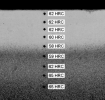Last night I repeated the process. As I looked at the edge I produced the other night a little closer, I thought I could do a better job. So I went back starting with a 200 stone and moved through 400 600, 800, 1000, and finally the strip. I really took my time doing it, and used plenty of water. The results were even better. I don’t have a beaming shiny edge, but it’s pretty damn polished and the edge is screaming sharp per my definition. The tip to Ricoso edge of the knife push cuts phonebook paper with zero effort.
Something else I noticed using the belt grinder versus the edge pro water stones, is that no matter what I always ended up with a convex edge using that bell grinder, due to some of that bend you can impart on the belt when you’re pushing down on it. I thought I could avoid it by not pushing as hard but there’s always a little bit of flex in the belt when you’re grinding and that leads to that convex edge.
I want to keep the belt grinder for garden tools and other shit like that, but I think I’m totally committed to using the water stones from here on out, even such that I ordered some Chosera stones and some polishing tape for the edge pro.
I’ve been watching some videos with that Tourmek T8, and damn does that not look like a sweet piece of machinery. But after the machine and accessories you’re getting close to like almost a $1000 worth of kit. Anyone using this system?
I want to thank everyone for the great advice and guidance, it is accomplishing to put the suggestions into action and have some really good outcomes.
On a slightly unrelated topic. I just picked up a new Shiro quantum and I noticed the actual bevel is so small as it relates to the face of the blade, it’s something like an eighth of an inch bevel at what I understand to be 20DPS. How does the maker of the knife get that bevel so small? It’s clearly a belt grind, but I have to assume they must be using a jig or some form of automated sharpening to be that precise? Take a look at the magnified pic of this edge I’m taking about. That’s like 1/8”.



